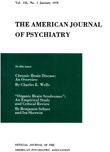Urinary catecholamine metabolites in hyperkinetic boys treated with d- amphetamine
Abstract
The authors studied the excretion of 3-methoxy-4-hydroxyphenyl glycol (MHPG), normetanephrine (NM), metanephrine, and homovanillic acid in 7 hyperactive and 12 control children. MHPG was lower but NM was significantly higher in hyperactive children than in controls. Administration of d-amphetamine for 2 weeks depressed the levels of MHPG, NM, and metanephrine. The authors suggest a decreased central norepinephrine activity, which may be secondary to the interruption of norepinephrine fibers in the medial forebrain bundle.
Access content
To read the fulltext, please use one of the options below to sign in or purchase access.- Personal login
- Institutional Login
- Sign in via OpenAthens
- Register for access
-
Please login/register if you wish to pair your device and check access availability.
Not a subscriber?
PsychiatryOnline subscription options offer access to the DSM-5 library, books, journals, CME, and patient resources. This all-in-one virtual library provides psychiatrists and mental health professionals with key resources for diagnosis, treatment, research, and professional development.
Need more help? PsychiatryOnline Customer Service may be reached by emailing [email protected] or by calling 800-368-5777 (in the U.S.) or 703-907-7322 (outside the U.S.).



